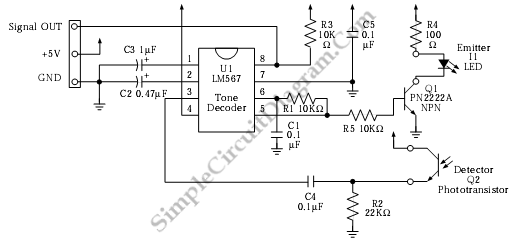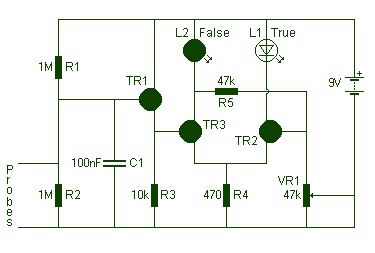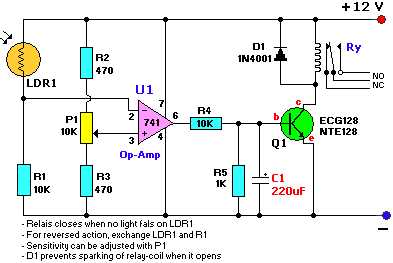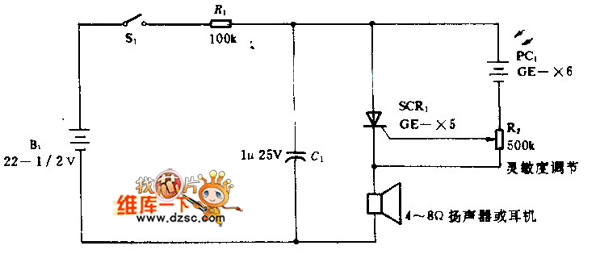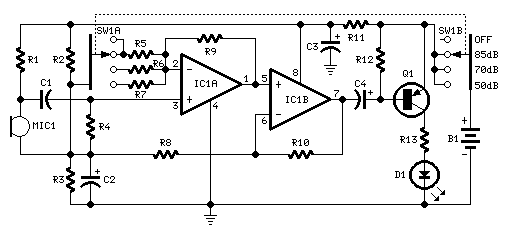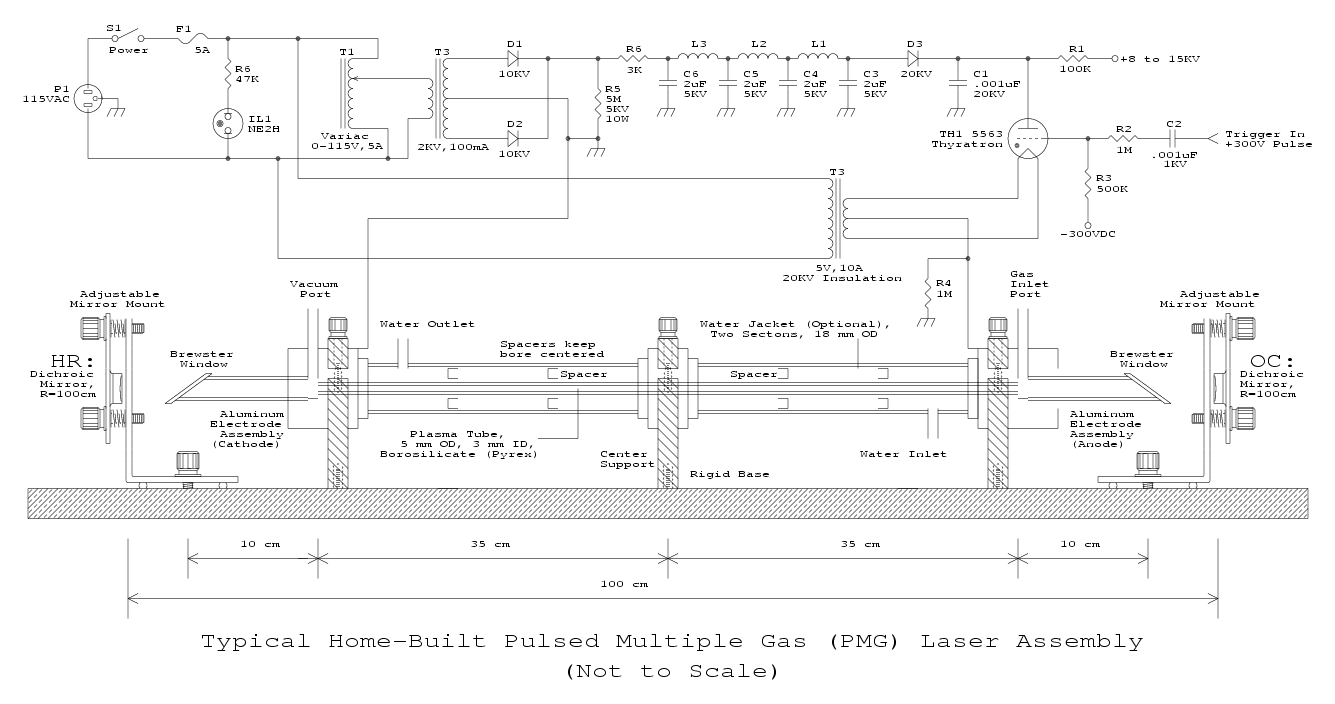
Laser light detector
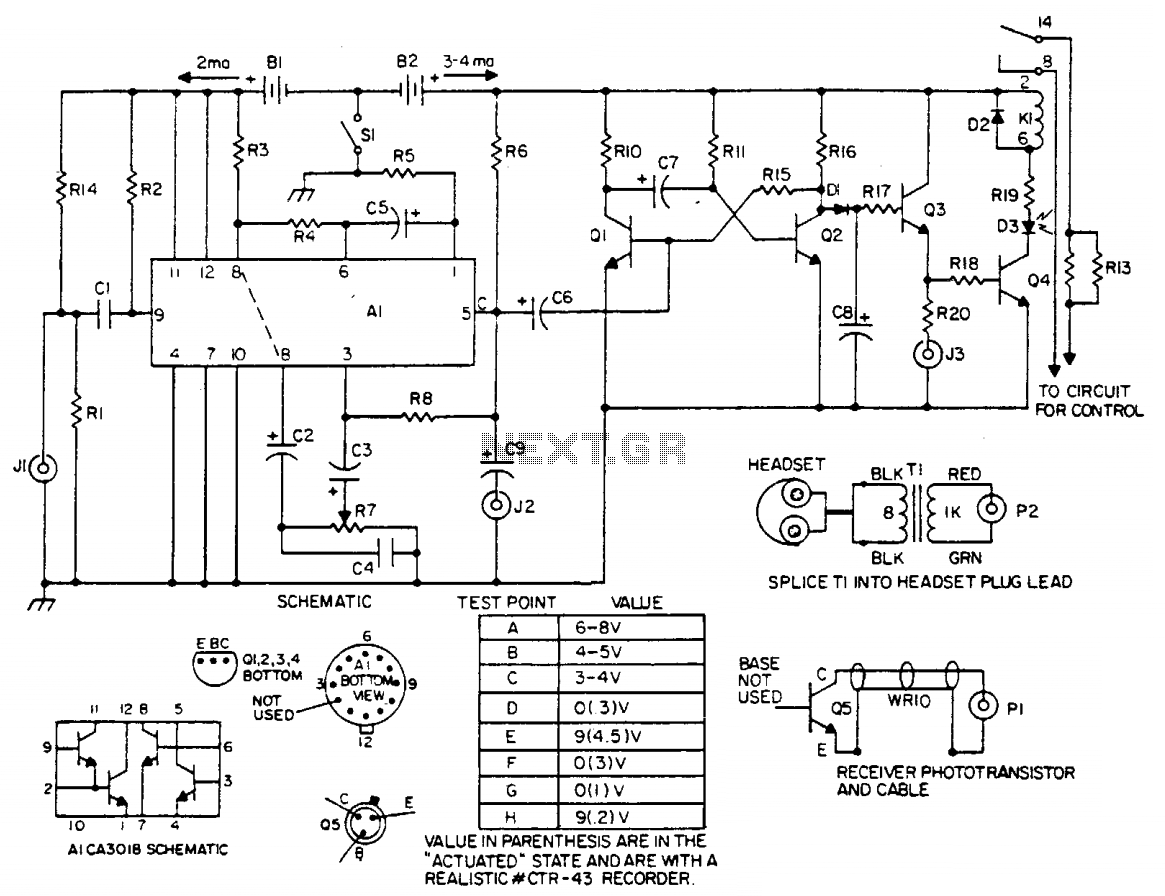
The laser light detector employs a sensitive phototransistor (Q5) positioned at the focal point of a lens (LE2). The output from Q5 is directed to a sensitive amplifier composed of an array (A1), which is biased through a voltage divider made up of resistors R14 and R1. The base of the phototransistor is not utilized. Q5 is capacitively coupled to a Darlington pair for impedance transformation and is subsequently connected to a cascaded pair of common-emitter amplifiers for additional signal amplification. A sensitivity control resistor (R7) adjusts the base drive to the final transistor of the amplifier array, thus modulating the overall system sensitivity. The output from the amplifier array is capacitively coupled to a one-shot circuit consisting of transistors Q1 and Q2, which integrates the output pulses of Q2 onto capacitor C8 through diode D1. This resulting DC level activates relay drivers Q3 and Q4, energizing relay K1 and indicator D3, thereby controlling the associated external circuitry. The contacts of K1 are connected in series with a low-ohm resistor (R13) to mitigate issues when switching capacitive loads. Connector J2 provides the ability to "listen" to the intercepted light beam through headsets, which is particularly advantageous when working with pulsed light sources such as GaAs lasers or other variable periodic light sources.
The laser light detector circuit is designed to provide high sensitivity and accurate detection of laser light. The phototransistor (Q5) serves as the primary sensor, detecting light intensity and converting it into an electrical signal. The configuration of the lens (LE2) ensures that the maximum amount of light is focused onto the phototransistor, enhancing the detector's responsiveness.
The sensitive amplifier stage, comprising the array (A1), is critical for amplifying the weak signals generated by the phototransistor. The biasing network formed by resistors R14 and R1 establishes the operating point of the amplifier, ensuring optimal performance. The Darlington pair configuration following Q5 serves to increase the input impedance and reduce loading effects on the phototransistor, allowing for better signal integrity.
The cascaded common-emitter amplifiers further increase the signal level, making it suitable for downstream processing. The sensitivity control resistor (R7) provides a means to fine-tune the detection threshold, allowing the user to adapt the circuit's response to different light sources or environmental conditions.
The integration of the output pulses via the one-shot circuit (Q1 and Q2) and capacitor C8 is a crucial step in converting the pulsed output from the amplifiers into a stable DC level. This DC signal is used to drive the relay drivers (Q3 and Q4), which control the relay (K1) that can switch external loads. The inclusion of the low-ohm resistor (R13) ensures that the relay can handle capacitive loads without arcing or damage during switching operations.
Finally, the ability to monitor the intercepted light beam through connector J2 enhances the functionality of the system, allowing for real-time audio feedback when working with pulsed light sources. This feature is particularly useful in applications involving precision alignment or monitoring of laser systems, ensuring that operators can make adjustments based on immediate feedback. Overall, the circuit is designed for robust performance in detecting and processing laser light signals, with features that enhance usability and reliability in various applications.The laser light detector utilizes a sensitive photo transistor (Q5) placed at the focal point of a lens (LE2). The output of Q5 is fed to a sensitive amplifier consisting of array (Al) and is biased via the voltage divider consisting of R14 and Rl.
The base is not used. Q5 is capacitively coupled to a Darlington pair for impedance transforming and is further fed to a capacitively coupled cascaded pair of common-emitter amplifiers for further signal amplification. Sensitivity control (R7) controls base drive to the final transistor of the array and hence controls overall system sensitivity.
Output of the amplifier array is capacitively coupled to a one-shot consisting of Ql and Q2 in turn integrating the output pulses of Q2 onto capacitor C8 through Dl. This dc level now drives relay drivers Q3 and Q4 activating K1 along with energizing indicator D3, consequently controlling the desired external circuitry.
The contacts of K1 are in series with low ohm resistor R13 to prevent Mure when switching capacitive loads. J2 allows "listening" to the intercepted light beam via headsets. This is especially useful when working with pulsed light sources such as GaAs lasers or any other varying periodic light source.
The laser light detector circuit is designed to provide high sensitivity and accurate detection of laser light. The phototransistor (Q5) serves as the primary sensor, detecting light intensity and converting it into an electrical signal. The configuration of the lens (LE2) ensures that the maximum amount of light is focused onto the phototransistor, enhancing the detector's responsiveness.
The sensitive amplifier stage, comprising the array (A1), is critical for amplifying the weak signals generated by the phototransistor. The biasing network formed by resistors R14 and R1 establishes the operating point of the amplifier, ensuring optimal performance. The Darlington pair configuration following Q5 serves to increase the input impedance and reduce loading effects on the phototransistor, allowing for better signal integrity.
The cascaded common-emitter amplifiers further increase the signal level, making it suitable for downstream processing. The sensitivity control resistor (R7) provides a means to fine-tune the detection threshold, allowing the user to adapt the circuit's response to different light sources or environmental conditions.
The integration of the output pulses via the one-shot circuit (Q1 and Q2) and capacitor C8 is a crucial step in converting the pulsed output from the amplifiers into a stable DC level. This DC signal is used to drive the relay drivers (Q3 and Q4), which control the relay (K1) that can switch external loads. The inclusion of the low-ohm resistor (R13) ensures that the relay can handle capacitive loads without arcing or damage during switching operations.
Finally, the ability to monitor the intercepted light beam through connector J2 enhances the functionality of the system, allowing for real-time audio feedback when working with pulsed light sources. This feature is particularly useful in applications involving precision alignment or monitoring of laser systems, ensuring that operators can make adjustments based on immediate feedback. Overall, the circuit is designed for robust performance in detecting and processing laser light signals, with features that enhance usability and reliability in various applications.The laser light detector utilizes a sensitive photo transistor (Q5) placed at the focal point of a lens (LE2). The output of Q5 is fed to a sensitive amplifier consisting of array (Al) and is biased via the voltage divider consisting of R14 and Rl.
The base is not used. Q5 is capacitively coupled to a Darlington pair for impedance transforming and is further fed to a capacitively coupled cascaded pair of common-emitter amplifiers for further signal amplification. Sensitivity control (R7) controls base drive to the final transistor of the array and hence controls overall system sensitivity.
Output of the amplifier array is capacitively coupled to a one-shot consisting of Ql and Q2 in turn integrating the output pulses of Q2 onto capacitor C8 through Dl. This dc level now drives relay drivers Q3 and Q4 activating K1 along with energizing indicator D3, consequently controlling the desired external circuitry.
The contacts of K1 are in series with low ohm resistor R13 to prevent Mure when switching capacitive loads. J2 allows "listening" to the intercepted light beam via headsets. This is especially useful when working with pulsed light sources such as GaAs lasers or any other varying periodic light source.
